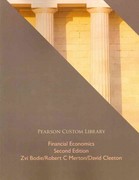Answered step by step
Verified Expert Solution
Question
1 Approved Answer
. An investor buys a 10 year, 8% annual coupon bond at par (so the yield-to-maturity must be 8%), and sells it after three years
.
- An investor buys a 10 year, 8% annual coupon bond at par (so the yield-to-maturity must be 8%), and sells it after three years (just after the coupon is recieved). Interest rates rise immediately after the purchase, and the bonds yield-to-maturity jumps to 10% and remains there for the rest of the three year period. Assume coupons are reinvested at the new yield-to-maturity.
- Show the components of the investors total return, or portfolio value at the end of the three year period. Your answer should include dollar values for the receipt of scheduled payments, the reinvestment income, and the sale price of the bond. Base your calculations on $100 par value.
- What is the investors horizon yield, or realized rate of return, expressed on an annualized basis? If it is different from the bonds original yield-to-maturity, what explains the difference?
Step by Step Solution
There are 3 Steps involved in it
Step: 1

Get Instant Access to Expert-Tailored Solutions
See step-by-step solutions with expert insights and AI powered tools for academic success
Step: 2

Step: 3

Ace Your Homework with AI
Get the answers you need in no time with our AI-driven, step-by-step assistance
Get Started


